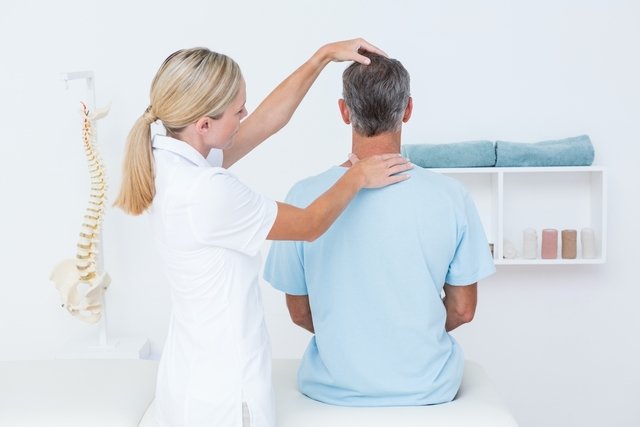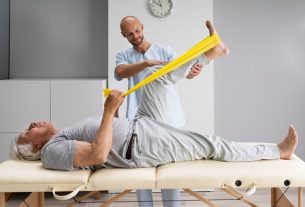Cervical uncoarthrosis is a wear and tear of the cartilage of the intervertebral discs in the cervical spine, located in the neck, which become less elastic due to the loss of water and nutrients, resulting in symptoms such as pain in the neck, burning sensation, or tingling in the arms, for example. .
Cervical uncoarthrosis is a type of osteoarthritis, which is more common in older people, due to the natural wear and tear of joints as the body ages, or as a result of repetitive movements or trauma, for example.
The treatment of cervical uncoarthrosis is carried out by an orthopedist or rheumatologist, who may recommend the use of medication to alleviate symptoms, physiotherapy and, in the most serious cases, surgery.

Symptoms of cervical uncoarthrosis
The main symptoms of cervical uncoarthrosis are:
- Pain and burning sensation in the neck;
- Pain that radiates to the shoulders, arms or head;
- Stiffness in the neck;
- Difficulty moving the neck;
- Feeling of heaviness in the neck or arms;
- Presence of clicking noises when moving the neck;
- Feeling of sand when moving the neck;
- Frequent headache;
- Tingling sensation in one or both arms;
- Muscle weakness;
- Tremor in the arms or hands;
- Difficulty moving arms or hands;
- Loss of strength in arms or hands;
- Loss of arm movement;
- Loss of balance.
Furthermore, as the disease progresses, deformity in the cervical region or changes in neck posture may also appear, which can make symptoms more intense.
Therefore, it is important to consult an orthopedist or rheumatologist whenever symptoms of cervical uncoarthrosis appear, so that the diagnosis can be made, the possible cause identified and the most appropriate treatment initiated.
How to confirm the diagnosis
The diagnosis of cervical uncoarthrosis is made by an orthopedist or rheumatologist through the evaluation of symptoms, personal and family health history, lifestyle habits and physical examination, in which movements are carried out in the neck with the aim of checking whether there are any limitations. of movement or if there is pain during it.
Additionally, the doctor may order imaging tests, such as X-ray or MRI, to check the degree of wear on the cervical joint and thus confirm the diagnosis and indicate the most appropriate treatment.
Possible causes
The exact cause of cervical uncoarthrosis is not fully known, however, it arises due to the wear of the cartilage between the vertebrae of the cervical spine, which results in the contact of one bone with another and inflammation, since the cartilage’s function is to protect the joint, preventing friction between the bones, in addition to providing stability and guiding the movements of the cervical spine.
Some factors may contribute to increasing the risk of developing cervical uncoarthrosis, such as:
- Natural aging of the body, leading to joint wear;
- Family history of cervical uncoarthrosis;
- Congenital joint deformities;
- Muscle weakness;
- Misalignment of the cervical joint;
- Smoking habit;
- Injuries, such as fractures, sprains or blows that affect the neck joint;
- Repetitive movements, such as repetitively lifting heavy objects;
- Jobs that put stress on the neck joints, such as dentists, nurses, seamstresses, painters or people who perform domestic work.
These factors can cause progressive degeneration and destruction of the joint, resulting in symptoms.
How the treatment is carried out
The treatment of cervical uncoarthrosis must be carried out under the guidance of an orthopedist or rheumatologist, with the aim of relieving symptoms and preventing the disease from progressing.
Therefore, the main treatments recommended by the doctor are:
- Use of cervical strainin the acute phase of cervical uncoarthrosis;
- Analgesic and anti-inflammatory medicationssuch as paracetamol, diclofenac, ibuprofen or naproxen, to reduce pain and inflammation in the neck;
- Supplementssuch as glucosamine sulfate and chondroitin, which help lubricate and maintain the elasticity of cartilage in joints;
- Global postural reeducation (RPG)to correct poor posture and help alleviate symptoms;
- Physiotherapyto help strengthen neck muscles, increase flexibility and reduce pain by improving neck movement and reducing stiffness.
Furthermore, in more serious cases, in which there is compression on the spinal cord or nerve roots, the doctor may recommend surgery to release these nerve structures and stabilize the cervical spine.
Bibliography
- HARTMAN, J. Anatomy and clinical significance of the uncinate process and uncovertebral joint: A comprehensive review. Clin Anat. 27. 3; 431-40, 2014
- KUSHCHAYEV, Sergiy et al. ABCs of the degenerative spine. Insights Imaging. 9. 253–274, 2018
- SPANISH SOCIETY OF RHEUMATOLOGY. Artrosis Cervical. 2017. Available at: <https://inforeuma.com/wp-content/uploads/2017/04/52_Artrosis-Cervical_ENFERMEDADES-A4-v03.pdf>. Access on March 29, 2022
- UNIVERSITY CLINICAL HOSPITAL OF VALLADOLID. CERVICOARTROSIS. Available at: <https://unitia.secot.es/web/manual_residente/CAPITULO%2066.pdf>. Accessed on March 29, 2022
- SPANISH SOCIETY OF MEDICAL RADIOLOGY. Degenerative spine: a difficult challenge for the resident to face. Importance of the unification of criteria and systematics for the preparation of a radiological report with magnetic resonance imaging (MRI). . Accessed on March 29, 2022

Sign up for our newsletter and stay up to date with exclusive news
that can transform your routine!
Warning: Undefined array key "title" in /home/storelat/public_html/wp-content/plugins/link-whisper-premium/templates/frontend/related-posts.php on line 12
Warning: Undefined array key "title_tag" in /home/storelat/public_html/wp-content/plugins/link-whisper-premium/templates/frontend/related-posts.php on line 13



